Author: David Ashton
My old friend Max wrote an article titled “What is the Best Travel Tool?” which reminded me of the multimeters I have owned, currently own, and wish to own in the future. These multimeters range from simple, inexpensive analog meters to high-quality Flukes. In the realm of digital multimeters, especially handheld ones, Fluke undoubtedly has a stellar reputation, though there are many other good brands as well. I still hope to own a high-quality HP/Agilent 34410A 6½ digit digital multimeter.
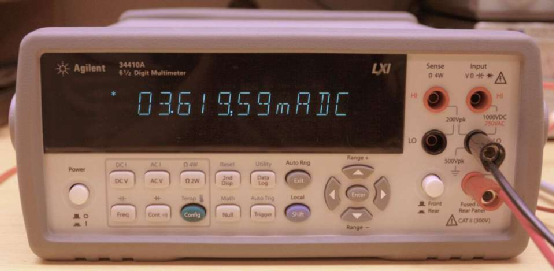
When a person starts to develop an interest in electronics, a multimeter may be the first testing device they purchase (or receive, like I did), and it can be one of the most memorable testing devices. I have quite a few multimeters in my house, some of which were given to me by others.
While writing this article, I counted all my multimeter treasures and found that I have at least 15. Recently, a supplier who was clearing out stock due to a change in business gave me 7 multimeters, most of which were priced under 10 yuan. I sold a few, gave some away, and kept 2 or 3 because I am working on a breadboard system and might need them.
I share these multimeters with my readers, hoping to evoke fond memories of beloved multimeters among my engineering friends.
Unforgettable Multimeters from Memory
My first multimeter was a Japanese Sanwa. It was a small analog meter that a fellow electronics enthusiast friend gave me when I was about 13 years old. I struggled to get it to work—I guess that’s why my friend gave it to me. This multimeter is long gone, but it helped me a lot during the first few years of my interest in electronics. It’s been so long that I’ve forgotten its exact appearance, but it seemed to look something like this. I still vividly remember not understanding what the strange dB range was…
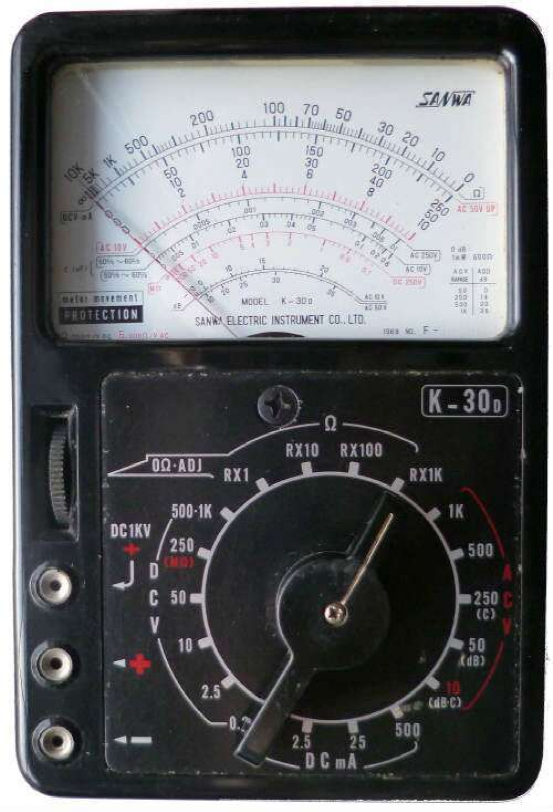
My second multimeter was a Kyoritsu (KEW) K-1400, which I had my dad buy for me when he was on a business trip to South Africa. I still remember the immense joy of taking the multimeter out of the box. It was quite a professional 20KΩ/V mirror scale multimeter. The picture above is of an Eagle brand multimeter, which looks the same as mine. When I moved from Zimbabwe to Australia in 2002, I didn’t take this multimeter with me, and it’s been lost ever since, which makes me quite sad.
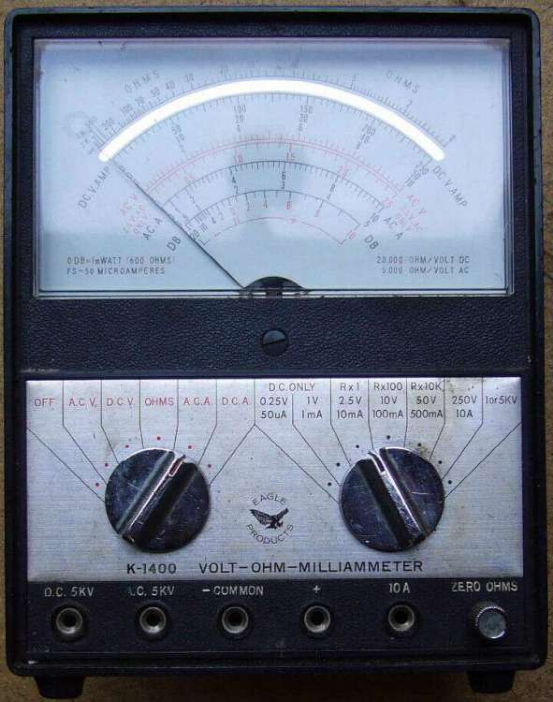
Many years ago, when I started working in the well-known radio department of the British South African Police in Rhodesia, each person was issued an Avometer. AVO (named after Amps-Volts-Ohms) is a large British instrument manufacturer. Avometers are very sturdy and almost indestructible, and they were still in production as of 2008. They are large and heavy for fieldwork, and reading them on the workbench can be difficult, so I wouldn’t use them in either case. But like Land Rovers, they may not be the best cars, but those who have used them will reminisce. Many older engineers simply refer to multimeters as “Avo,” which is quite common. AVO has now been acquired by the Megger Group, and many people refer to all instruments for testing insulation resistance as “Megger,” regardless of their origin. Look at me digressing…
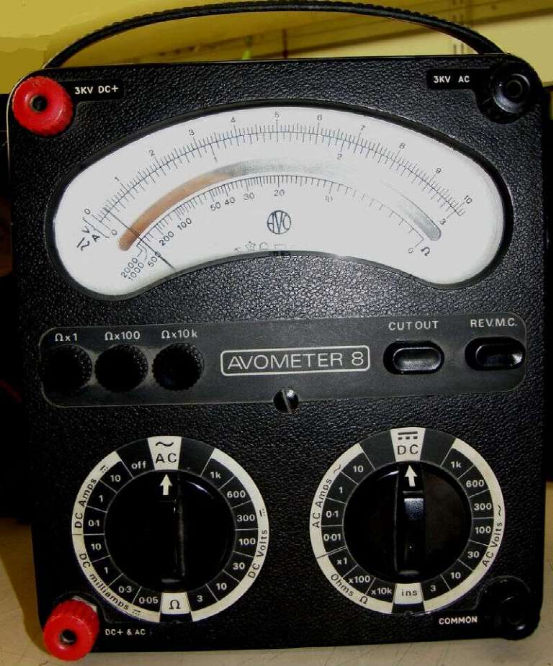
This is the first Keithley 130A digital multimeter I ever owned, which I remember buying in the late 1970s, and it is still in good condition. I left it in Zimbabwe and can still use it when I occasionally go back there. I had a colleague in the radio department named Keith Lee, and I remember showing him: “Hey, Keith Lee, come look at my Keithley!” Keithley is now part of Tektronix and continues to manufacture high-quality multimeters.
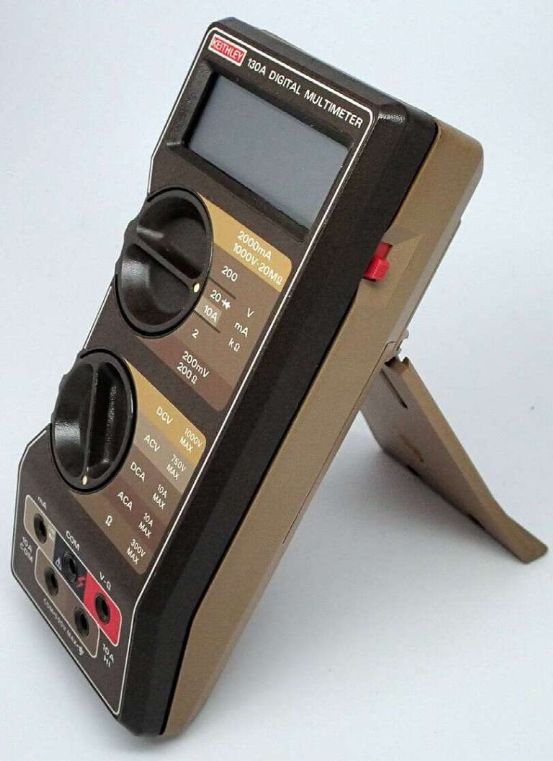
AC Ammeters
I don’t know if most engineers classify them as multimeters since they actually measure AC current (with clamps – non-contact) and voltage, so I include them as well. Back in the day, Tandy in Paris had these ammeters for a special price of 20 francs each, which is just a few dollars. A few years ago, I bought 4 of them, and after returning to Zimbabwe, I sold 3 of them for a good profit, keeping one for myself, which is still in Zimbabwe and much cleaner than the one in the picture! A few years later, I became an electrician, and this was my go-to instrument—when dealing with mains electricity, voltage and current are usually the only parameters of interest. This ammeter doesn’t even require a battery!
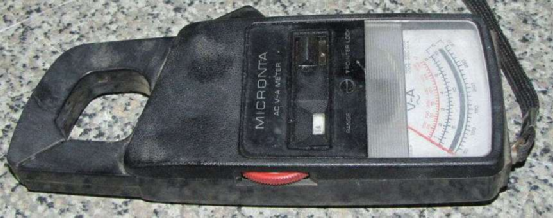
This one has a bit of a modern feel, but it’s already over 20 years old. It no longer works properly, so I think I’ll throw it away. When I opened the case, I found a DVM chip, an LM324 quad op-amp, and some other components inside. After replacing the LM324, the multimeter started working again, but I still need to make some adjustments because it cannot zero correctly. For such an old product, Hioki surprisingly provided me with a service manual, which piqued my interest in the company. The modern versions of these instruments are essentially digital multimeters, many of which can perform the same measurements as non-clamp multimeters. However, they do require batteries!
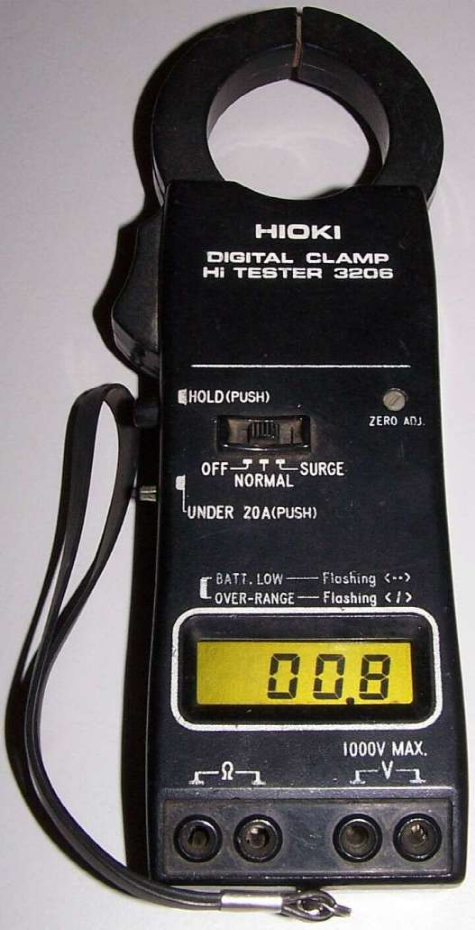
Old-fashioned Student Analog Multimeters
In our day, multimeters were usually analog, and one major advantage was that they didn’t require batteries for measuring voltage and current. Measuring resistance does require a battery, but even when the battery is low, you can usually get fairly accurate measurements by adjusting the “zero” knob and/or a bit of compensation and calibration. I still have a few cheap little analog multimeters that work without batteries, making them ideal for toolkits. Toolkits are rarely used, so low accuracy isn’t a big deal. I bought a few for almost a few dollars at a market in London. The one in the picture has a battery test mark and a mirror scale! But it’s only 2KΩ/V…
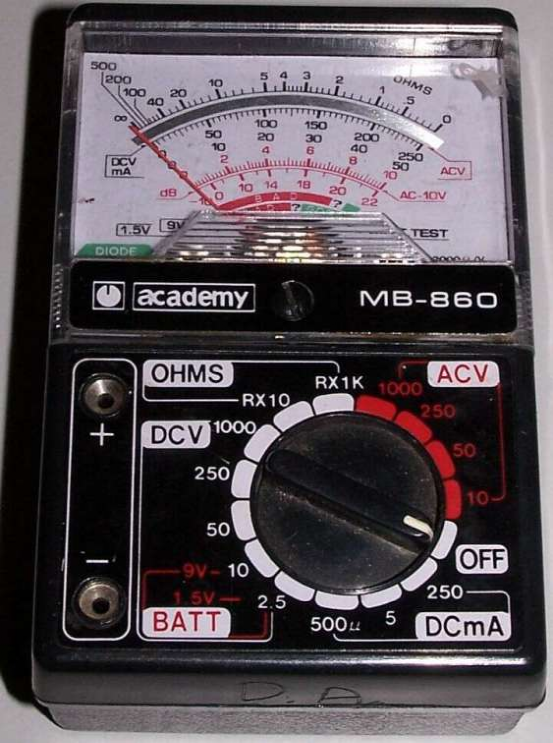
Another analog multimeter is slightly larger than my old Sanwa and of better quality. This multimeter works perfectly, but I hardly ever use it, yet I can’t bring myself to throw it away. It has a nice range of 20KΩ/V, a mirror scale, and is portable. By the way, have you ever wondered why this instrument has an “Off” position on the switch? It can appropriately buffer the movement of the meter, reducing the risk of damage from drops or impacts.
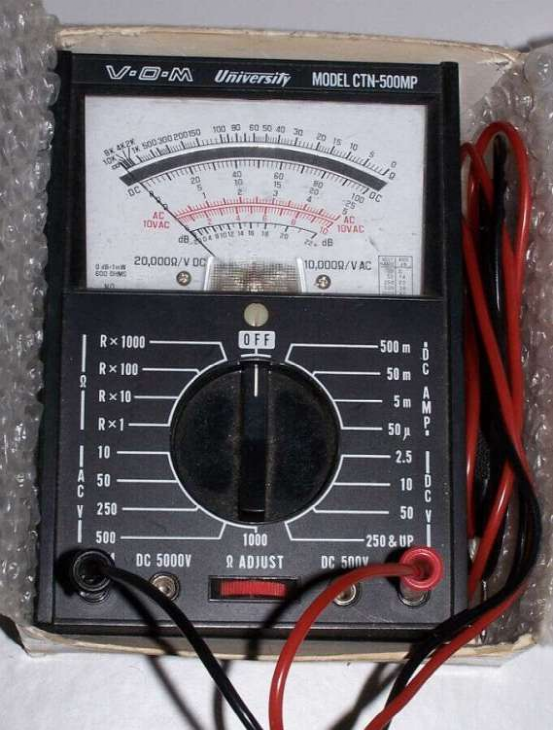
Inexpensive Digital Multimeters
Back to digital multimeters. This one represents multimeters priced at 10 yuan or less. It has suitable accuracy, usually offers diode and transistor testing, and if you’re lucky, it also provides a 10A current range (this one does), a capacitance testing range (this one doesn’t), and a continuity beep function (this one also doesn’t). However, once these digital multimeters break, you usually just throw them away. I’ve repaired a few, generally due to PCB trace damage from battery leakage or cracks from drops, but if the LCD is damaged or the range switch is broken, it’s not worth repairing, as it’s difficult to fix and even if repaired, it’s not cost-effective.
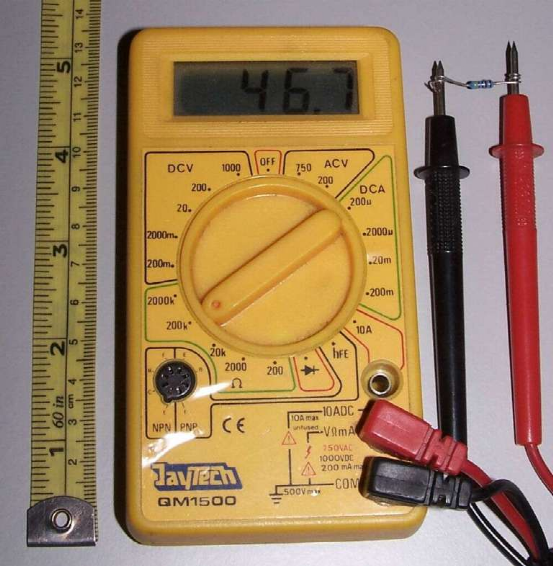
This is the back of a digital multimeter (the case has been opened). Note that this PCB is designed for the ubiquitous ICL7106 IC, but it uses a bare chip on a thin PCB instead of an IC, which undoubtedly saves a few cents. Also note the 10A shunt in the lower left corner and several notches for calibration. Although it doesn’t look great, the quality is decent, and it’s inexpensive, offering good value for money.
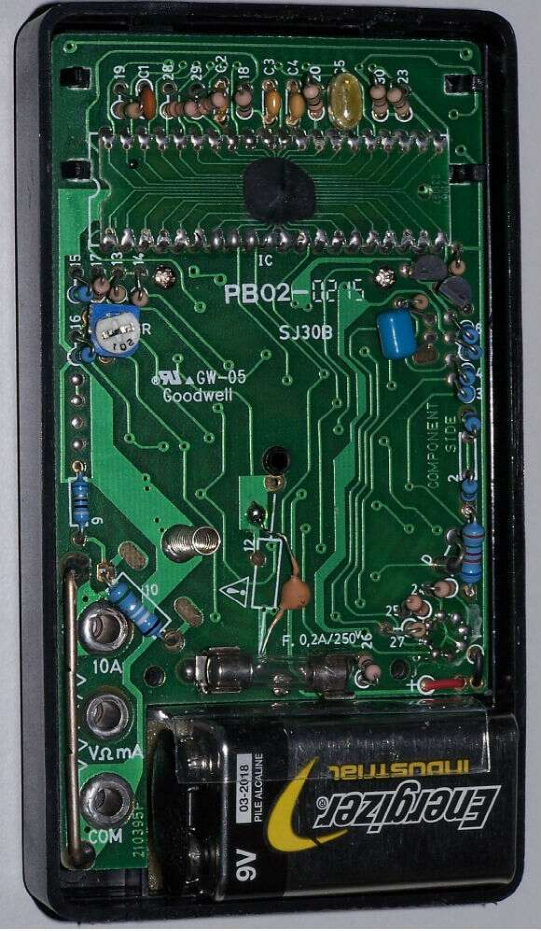
This multimeter is quite good, but it has already been discontinued, and I don’t know why. The display is quite good, with large digital and bar graph indicators, and it has capacitance, transistor, and diode testing ranges. I’m keeping it for when I get older (well… when I get even older), and my eyesight isn’t as good… to use. The picture shows it measuring a small capacitor.
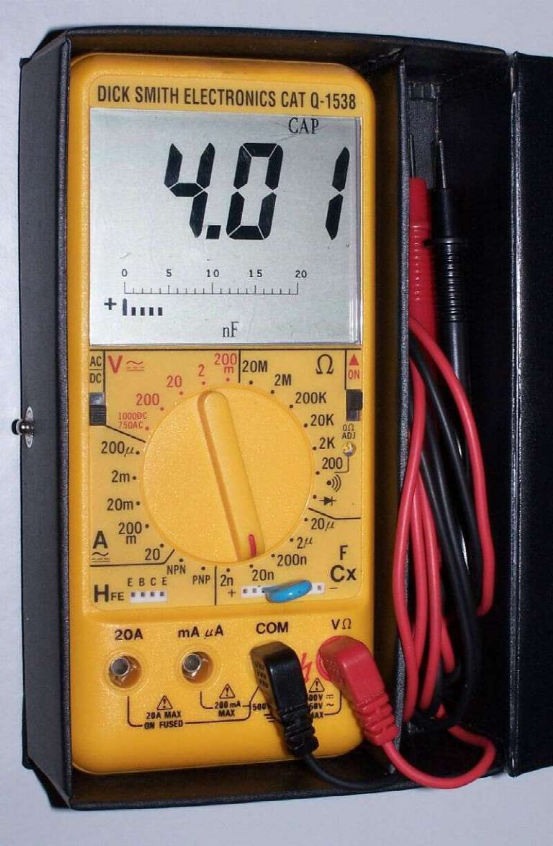
Compact and Powerful Multimeters
Over the years, multimeters have become smaller and more attractive. If someone brought a watch multimeter, I wouldn’t be surprised; however, I don’t have such a small multimeter (where would I put the probes?). The multimeter in the picture measures 94×46×26 mm (3.7×1.8×1 inches)—1 inch thick isn’t exactly pocket-sized, and it doesn’t have a cover to secure the test leads. But this small multimeter is fully functional, with a DC current range of up to 10A, providing diode and transistor testing, and most importantly, it has full-size 4mm banana plugs, making it easy to buy or make a set of alligator clip test leads to use with it. Comparing it to the first standard digital multimeter above, this one is labeled QM1502, while the previous one is labeled QM1500, and they have the same ranges, so they may come from the same manufacturer.
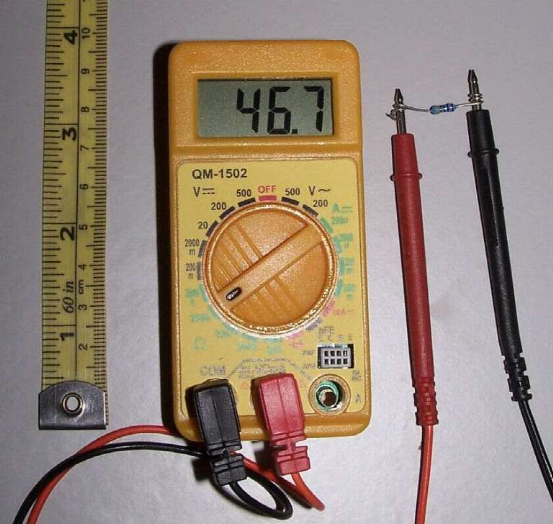
Several manufacturers offer “credit card-sized” multimeters; mine is made by Tenma. It’s small, but still larger than a credit card (4-1/4×2-1/4 inches, ½ inch thick), so it can only fit in a shirt pocket. It also comes with a protective case and a test lead/probe holder. The Amprobe DM78C is about the same size. Both of these multimeters can only measure voltage and resistance, not current, and have limited functionality, but this multimeter can also measure frequency and duty cycle, and has hold and relative value buttons. I once had a multimeter that was even smaller than this, smaller than a credit card, but it had very limited functionality and broke quickly. The test leads on these small multimeters are directly inserted, so they are bound to fail, it’s just a matter of time.
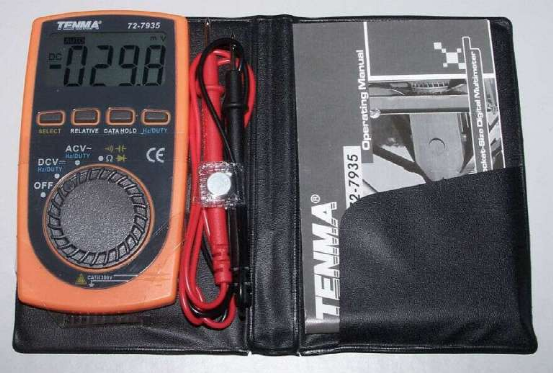
And These and Those…
At the beginning of the article, I mentioned that a supplier gave me 7 multimeters, and this is the best one among them. It’s an automotive tester that should come with a test probe (the supplier didn’t give me one, but I can make one when needed), which connects to a spark plug wire on a car to provide RPM readings. It can also measure closed angle, duty cycle, and low frequency, and has a K-type thermocouple socket for measuring temperature. Hey, look! I have a thermometer.
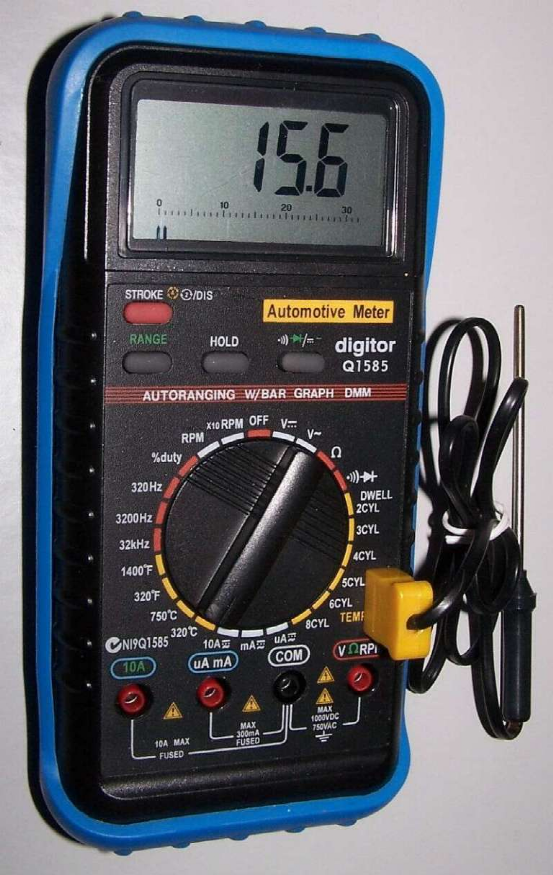
The software and PC connection cable for this multimeter cost me $5 during a clearance sale. Then I found a matching multimeter on E-bay for $60, and now I have a data logger. This is still a very classic multimeter, offering many uncommon measurements—frequency and duty cycle, capacitance, temperature (via the thermocouple adapter shown in the picture), and even a 4~20mA range, with the following features: hold, relative value, recording minimum, maximum, and average readings (the internal software records everything), peak readings, backlight, and a magnetic clip to attach it to any steel object. This multimeter can work with Labview, for which I even downloaded the VI.
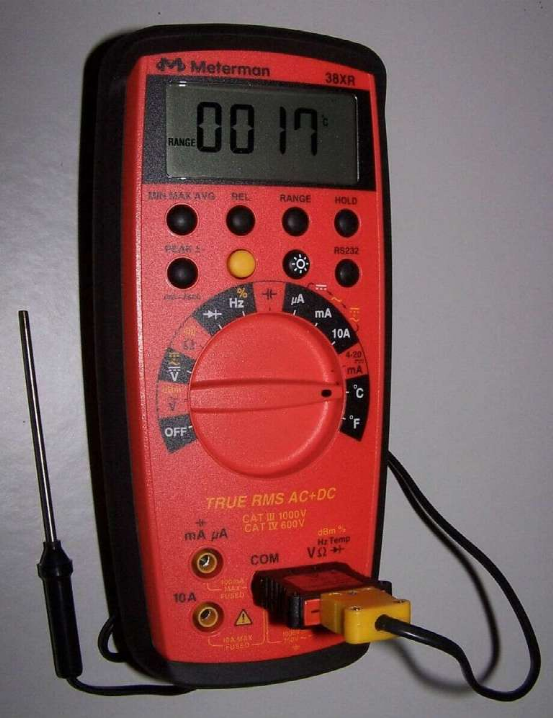
This isn’t a true multimeter, but it looks and operates like one, and it’s very practical, so I included it as well. This is an LCR meter, costing $50, which my wife gave me as a birthday gift a few years ago. It’s not as good as a professional LCR meter, as it cannot set the test frequency, but it’s very useful for quickly testing components and can also be used to estimate turns ratio. The picture shows it measuring the inductance of an audio transformer, along with the tweezers probe that comes with it—really great for SMD components, and only a few dollars.
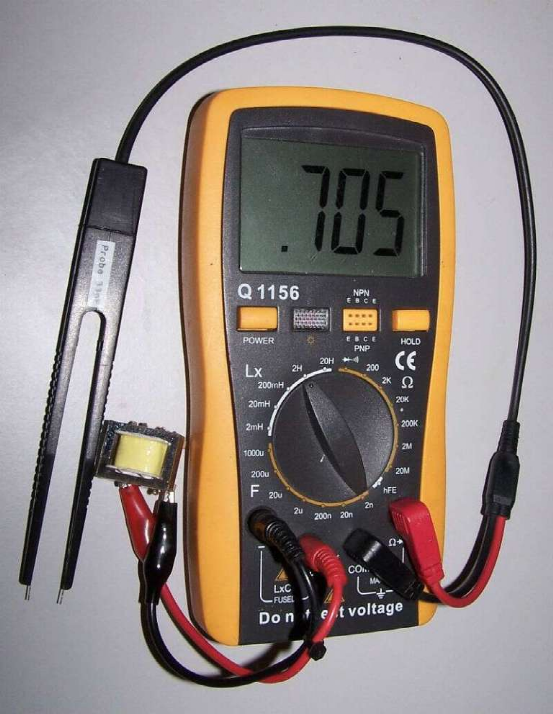
My Pride, My Source of Happiness
This is my Fluke 8050A, my pride and joy. I bought it new in the early 80s, and recently while cleaning it, I accidentally removed the $375 price tag. I still have the original soft case, which has a tray for holding test leads, and the manual, and even the packaging box is still intact. I’ve only replaced the display once, and it’s still in great condition. It has a 4-1/2 digit display, and besides the common voltage, current, and resistance measurements, it also has dB and conductance ranges. It has a “relative value” button that allows measurements relative to the moment it’s pressed. This feature is very useful when testing low-value resistors (zeroing the test leads’ resistance) or checking the cells of a NiCd battery pack. Measure the first one, then press the “REL” button, and then just move the positive probe to measure the second one. Switching REL for each measurement can quickly complete the entire battery pack. Or you can find a few matching resistors from a pile—measure the first resistor, press REL, and keep only those resistors with a small difference from the first one. The only downside of this instrument is that it doesn’t have a continuous beeper, but that doesn’t detract from it being an excellent multimeter.
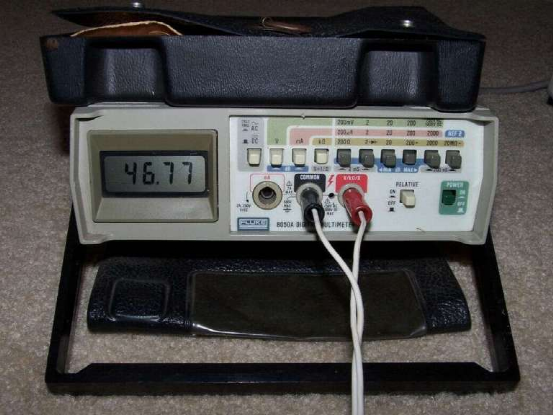
There’s a simple transistor tester attachment diagram in the Fluke manual that works in the conductance range and provides Hfe readings (just move the decimal point three places to the right). I built a tester according to the diagram, which I use frequently. The picture shows it measuring an NPN transistor (BC 548) with an Hfe of 373.8. If measuring a PNP, you can insert it in the opposite direction. You can use clips like the one in the picture or sockets, which are not visible in the picture on my right.
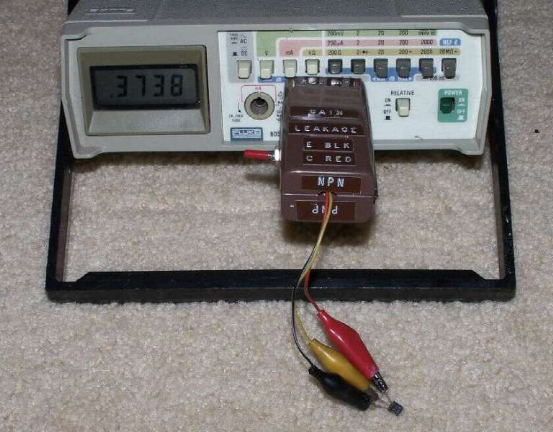
Fluke is another company that provides good technical support for very old products. I still have the original manual for the 8050A, and someone gave me its little brother, the 3-1/2 digit 8010A, for which I downloaded the service manual online. Both of these multimeters had broken LCDs, which I replaced with new ones. There are also instructions online on how to replace the LCD with a 7-segment LED display. These two digital multimeters have always been on my workbench, and I use them from time to time.
What to Consider When Buying a Multimeter?
Before concluding this article, I’d like to remind friends of some considerations when purchasing a multimeter. Multimeters have four categories: 1, 2, 3, and 4, as defined by the International Electrotechnical Commission (IEC). Cat1 is basically for low electronic devices and is practically useless. Theoretically, Cat2 multimeters can be used to measure from wall outlets, but all measuring personnel should actually use Cat3 (building distribution) or Cat4 (utility connection) rated multimeters. The small or inexpensive digital multimeters mentioned above mostly only meet CAT2 specifications, but the red Meterman XR38 shown above has Cat3 and Cat4 ratings. Any operation at mains voltage must ensure that the multimeter is Cat3 or Cat4 rated. Typically, such compliant products can only be purchased from higher quality manufacturers like Agilent or Fluke, and of course, they will be more expensive. Cat3 or Cat4 ratings indicate that when measuring, if there are voltage spikes in the mains, there will be no arcing in the multimeter or test leads, thus avoiding electric shock to the operator.
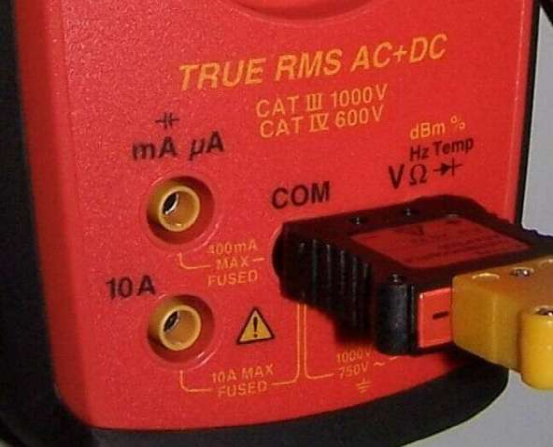
As shown in the picture above, many people are confused by the “X ohms/volt” rating on analog multimeters. This is simply a measure of the load that the multimeter places on the circuit being measured. If the multimeter range is 50mA, the resistance required to obtain 50mA current at 1 volt is 20KΩ. Therefore, if you use this multimeter to measure 2V, the total resistance (the multimeter resistance plus the “multiplier” resistance) will be 40KΩ. Hence, it is specified as 20KΩ/V. If measuring 100V, the resistance will be 100×20KΩ=2MΩ. This is a quick way to calculate the load of a multimeter within a certain range. This is particularly important in the tube/valve era when impedances were often higher than in transistor circuits. I have seen a 50KΩ/V analog multimeter, while 20KΩ/V is generally considered quite good, and those cheap little multimeters may be as low as 1000Ω/V. The mini analog multimeter mentioned earlier is rated at 2000Ω/V. Digital multimeters do not have this limitation, with input resistances typically reaching 10MΩ.

Multimeters that can measure diodes (usually indicated by a diode symbol) should be tested within range; otherwise, the voltage across the probes may not be sufficient to forward-bias the diode. The readings indicate the type of diode—silicon is about 0.6 to 0.7, Schottky is 0.18 to 0.4, and germanium is 0.2 to 0.3, but the decimal point position may vary.
If measurements are to be taken in confined spaces, the “hold” function is very useful, as it can hold the measurement until it can be seen. Nowadays, some manufacturers offer wireless displays that can be detached from the multimeter, which is also very useful in such cases. Almost all digital multimeters today have a continuous “beeper” for testing wires in cables without having to constantly watch the meter.
I am a Brit who has lived in former British colonies and have never had (thus not mentioned) the beloved multimeters of American engineers and technicians, such as Triplett and Simpson. Everyone has their own treasures, and engineering friends, I look forward to hearing your stories about your beloved multimeters!
Translated by: Jenny Liao, EDN China
Edited by: Luffy Liu
‧‧‧‧‧‧‧‧‧‧‧‧‧‧ END ‧‧‧‧ 👇👇Click to read the original article to learn about the summit activities
👇👇Click to read the original article to learn about the summit activities